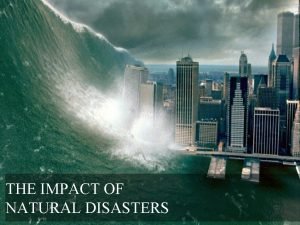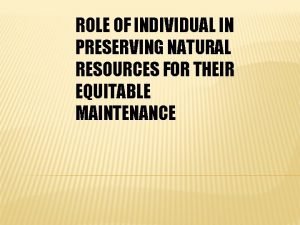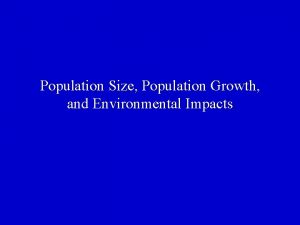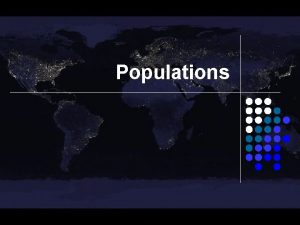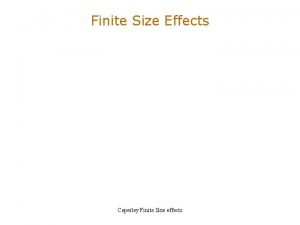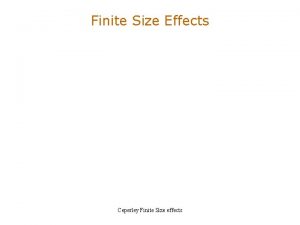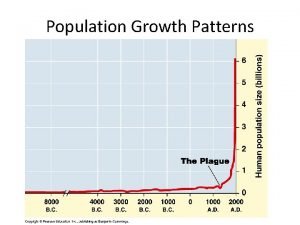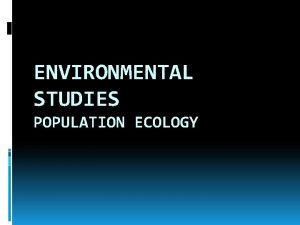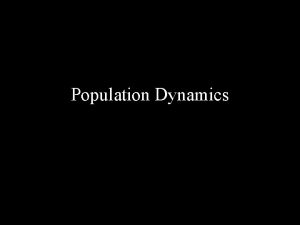Environmental Effects Change in population size due to












- Slides: 12

Environmental Effects Change in population size due to various environmental factors.

Objectives • (12 D) (Student Name READS) Recognize that long-term survival of species is dependent on changing resource bases that are limited. • (12 F) (Student Name READS) Describe how environmental change can impact ecosystem stability

Population Growth The changes in population size (population growth) can be communicated in graphs. Birth rate (number of organisms born) causes an increase in population size. Mortality (number or organisms that die) causes a decrease in population size. Besides birth and death rate, other factors will affect the population growth of a given species in a particular habitat.

Resources Food, water, shelter, and space are resources that are limited, and organisms compete for them as they struggle to survive. BAMBOO is a limited resource due to human interference A limited resource base can affect the long-term survival of a species, thus affecting the population growth.

Limiting Factors A resource that has the ability to LIMIT the population growth is called a limiting factor. 1. Density-Dependent Limiting Factors: depend on the size of the population. For example, an increase in pandas would mean the bamboo has the chance of running out. Other examples: food, shelter, water, disease transmission and ability to find a mate. 2. Density-Independent Limiting Factors: affect the population regardless of its size. For example, if a tsunami hits the panda habitat, the population will decrease no matter what its size was at that moment. Other examples: climate, weather and other natural disasters

Carrying Capacity Carrying capacity is the maximum amount of that organism that the habitat can support with resources. Once the panda population reaches a certain size, it has reached its “maximum” and the resources may begin to run out at that time. Limiting Factors will help the population maintain a relatively stable size!

Hunting, Fishing and Predation Hunting season for the deer population is highly regulated and is determined when the population has a “boom”, or sudden drastic increase due to birth-rate and reproduction. Hunting can bring the population back to carrying capacity! Fishing and predation have the same affect on population growth.

Population Growth CONTROLLED BY: MAINTAINED BY: SUCH AS: RESULTS IN:

Population Growth POPULATION GROWTH The maximum number of organisms (of one species) that the environment can support. CONTROLLED BY: CARRYING CAPACITY MAINTAINED BY: Factors that can limit population growth by causing it to slow down. LIMITING FACTORS Hunting/Fishing SUCH AS: Water availability Lack of space Lack of food Predation Disease RESULTS IN: STABILIZATION OF POPULATION GROWTH

Sample Population Growth Curve

Sample Population Growth Curve LIMITING FACTORS COME INTO PLAY AND LEVEL OFF THE POPULATION SIZE PO PU LA TIO NB OO M CARRYING CAPACITY POPULATION IS STABILIZING AT CARRYING CAPACITY.

 Rocks change due to temperature and pressure change
Rocks change due to temperature and pressure change Figura geometrica con quattro lati e quattro angoli uguali
Figura geometrica con quattro lati e quattro angoli uguali Substantive vs procedural due process
Substantive vs procedural due process Grande rhetra
Grande rhetra Principio di conservazione della quantità di moto
Principio di conservazione della quantità di moto Chapter 4 section 1 population dynamics answer key
Chapter 4 section 1 population dynamics answer key Section 1 population dynamics
Section 1 population dynamics Population ecology section 1 population dynamics
Population ecology section 1 population dynamics Study guide section 1 population dynamics
Study guide section 1 population dynamics Political impact of disaster slideshare
Political impact of disaster slideshare Major rishi nair
Major rishi nair Environmental pollution conclusion
Environmental pollution conclusion Wireless health
Wireless health









